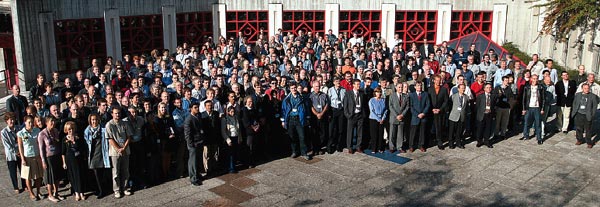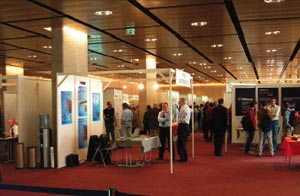In October 2005, control-systems experts from experimental facilities around the world met in Geneva for the EUROPHYSICS conference ICALEPCS 2005. Axel Daneels reports.
The International Conference on Accelerator and Large Experimental Physics Control Systems (ICALEPCS) is the prime conference in the field of controls for experimental-physics facilities, namely particle accelerators and detectors, optical and radio telescopes, thermo-nuclear fusion installations, lasers, nuclear reactors, gravitational antennas, and so on. The initiative to create this series of biennial conferences was taken at the end of 1985. An initial group of six laboratories – CERN, the Grand Accelerateur National d’Ions Lourds, the Hahn-Meitner Institut, Kern Forschung Anlage, Los Alamos National Laboratory and the Paul Scherrer Institut – were called upon to create an interdivisional group on Experimental Physics Control Systems within the European Physical Society (EPS) with the purpose, among others, of supporting these conferences. As a next step, CERN offered to organize the first ICALEPCS in 1987, in Villars-sur-Ollon.

The ICALEPCS circulate around the globe with meetings in Europe, America and Asia, co-organized by the EPS-EPCS, under the auspices of the Institute of Electrical and Electronics Engineers through its Nuclear and Plasma Science Society, the Association of Asia Pacific Physics Societies, the American Physical Society, the International Federation of Automatic Control, and the International Federation for Information Processing through its Technical Committee on Computer Applications in Technology.

ICALEPCS 2005, the 10th meeting in the series, fell auspiciously during the World Year of Physics, being held from 10-15 October 2005 at the Geneva International Conference Centre (CICG). It was hosted by CERN together with the Centre de Recherches en Physique des Plasmas (CRPP) of the École Polytechnique Fédérale de Lausanne (EPFL), and chaired jointly by CERN’s Bertrand Frammery and Jonathan Lister from CRPP-EPFL. Attendance reached 442, with delegates from 160 laboratories, universities and industries in 27 countries in Europe, America, Asia, and Oceania-Australia.

In the opening session, Axel Daneels of CERN, who is chairman of the International Scientific Advisory Committee and who has steered the ICALEPCS since their inception, introduced ICALEPCS 2005, and invited Carlo Lamprecht, Minister of Economy and Councillor of the State of Geneva to express his welcome and his support to the conference. Co-chair Lister welcomed the participants in his turn and was followed by Jos Engelen, CERN’s chief scientific officer, who presented the challenges raised by the CERN’s Large Hadron Collider (LHC) project – both the accelerator and the detectors.
Down to business
The first main sessions consisted of status reports on several major new and planned experimental-physics facilities around the world, with an emphasis on controls. Particle accelerators were represented by the LHC, the Japan Proton Accelerator Research Complex and CERN’s Low Energy Ion Ring. Synchrotron light sources covered the ELETTRA laboratory in Trieste, the SOLEIL synchrotron at Saint Aubin and the ALBA synchrotron near Barcelona. The fusion community described the controls of the National Ignition Facility (NIF) at Lawrence Livermore National Laboratory, the Angara-5 facility at the Troitsk Institute for Innovation and Fusion Research and the data challenges of the international project ITER. The presentations on telescopes discussed the controls of the Atacama Large Millimetre Array radio telescope in the Andes and the proposed Low Frequency Array in the Netherlands. CERN presented control systems for the CMS and ALICE detectors for the LHC. There were also presentations on the 8 GeV X-ray free-electron laser at the Japanese synchrotron radiation facility, SPring-8, and on VIRGO, the 3 km French-Italian gravitational-wave detection facility.
Special sessions
The session on process tuning, automation and synchronization heard how automation systems are crucial for reliable, coherent, safe and flexible operation of complex facilities such as NIF, VIRGO and the LHC detectors. The operation of tokamaks, such as the Joint European Torus in the UK and the Korea Superconducting Tokomak Advanced Research project, relies on real-time measurements and accurate synchronization systems. Low-level RF control systems were presented for the superconducting RF quadrupoles for the new positive-ion injector, Piave, at the INFN Laboratori Nazionali di Legnaro and for the LINAC-3 cavities at CERN. Synchrotron light sources, such as the Indus-2 storage ring at the Centre for Advanced Technology in Indore and Bessy II in Berlin, rely on orbit control and active feedback loops to position their optical components.
The session on security and other major challenges considered interlock systems combined with alarm-handling systems that monitor facilities operating in harsh environments in terms of radiation, temperature and so on. Security of computing networks for controls is an issue of concern for example at SPring-8 and CERN. The design of control systems for security and dependability was discussed in the context of the Dependable Distributed Systems (DeDiSys) research project supported by the European Union. Dependability covers availability, reliability, maintainability, safety and security.
Experimental-physics facilities are becoming more sophisticated and hence more demanding in matters of controls. However, control systems with many appropriate features are huge projects in themselves, which conflict with the reduction in resources that prevails in the research community. Laboratories are thus being driven into collaboration on the joint development of systems based on commercial hardware and software components – the topic of the session on development approaches. Collaboration frameworks are being developed to assure a streamlined and standard approach when integrating commercial components into a coherent system and to ease debugging, testing, deployment and maintenance. Collaborative projects include the Joint Controls Project for the LHC detector controls; the TANGO project for synchrotron radiation facilities, developed jointly by ALBA, ELETTRA, SOLEIL and the European Synchrotron Radiation Facility (ESRF) in Grenoble; and the ALMA Common Software project for distributed control.
The session on the evolution of hardware technology looked at how control-system architectures are evolving towards a higher granularity, thanks to the availability of small-size boards with an Ethernet port. This approach reduces the cost and improves the overall reliability. More specifically, while standard peripheral component interconnect (PCI) is still being supported for less demanding applications, PCI Express is becoming the only standard for connecting devices with high bandwidth requirements. In the domain of networking, 1 Gbit/s Ethernet is a consolidated standard, but a bandwidth up to 100 Gbit/s can already be found in projects such as ALMA. Networks with a low bandwidth are used as field buses. Programmable logic devices are the building blocks of digital controllers and are replacing complex boards based on digital-signal processors. Their importance is growing as they allow the integration of standard functions with custom application logic.
Middleware frameworks such as NIF’s large-scale CORBA framework were one of the topics of the session on the evolution of software technology. These have matured, and attention is shifting from mere deployment towards easier development. Application developers can be now shielded from particular middleware products and testing and integration of components can be facilitated through software simulation. Access to remote distributed resources is increasingly based on Web and Grid technologies. HyperDAQ, an application to provide access to distributed DAQ systems, employs web and peer-to-peer technology. The Virtual Instrument Grid Service, a part of the GRIDCC project, will use Grid computing to control distributed instrumentation.
The session on operational issues considered machine operations, which are tightly coupled to data management, alarm handling and remote collaboration. Operational information is managed through relational databases, as for example the configuration database for the LHCb experiment, while the commercial Geographical Information Systems are being applied to accelerator configuration management. Intelligence is added to alarm-handlers to reduce the incidence of unimportant alarms. Common frameworks, such as CERN’s Directory Services, tend to be introduced to integrate diverse systems operationally.
Experimental-physics facilities involve large investments and evolve during their lifetime – the subject of the session on dealing with evolution. Control systems must thus cope with this evolution while protecting the investment, so their architectures must be modular, data-driven and based on commercial products and standards. Examples are the JAPC Code (Java API for Parameter Control) developed to ease the programming of the LHC application software. Evolution often also implies proliferation of computers. Facing this phenomenon and to limit hardware failure and maintenance, SPring-8 has applied virtualization technology by which many computers are accommodated into a reduced number of virtual machines, each with independent resources (CPU, discs etc) as if they were stand-alone. Three virtualization approaches were discussed at the meeting: emulation of hardware or specific guest operating systems; multiplexing of physical resources by software; and application shielding to isolate applications from each other. By contrast, medical accelerators are designed for minimal upgrades and limited improvement during a lifetime, for safety and regulatory reasons.
Additional activities
The scientific programme was complemented by a three-day exhibition involving 17 companies and 10 technical seminars in which companies presented their views on the evolution of their technology as well as their strategy, and which were particularly well attended. In the week preceding ICALEPCS 2005, 150 controls specialists had also attended four workshops: Experimental Physics and Industrial Control System (organized by Matthias Clausen of DESY), ALMA Common Software (organized by Gianluca Chiozzi of ESO), TANGO (organized by Andy Götz of ESRF) and a Joint ECLIPSE Workshop (organized by Clausen and Götz). These workshops were held in France at Archamps, the Haute-Savoie’s business park near Geneva, and fully supported by the Conseil Général de la Haute-Savoie. In addition, Markus Völter from Völter-Ingenieurbüro für Softwaretechnologie, Germany, gave a tutorial on Model-driven Development of Distributed Systems at the CICG.
The conference also included a social programme featuring a welcome reception sponsored by Hewlett-Packard; wine-tasting parties, sponsored by the Canton wine producers; an organ and brass concert in the St Pierre Cathedral in Geneva’s old town, sponsored by the Republic and Canton of Geneva; a cruise with a banquet on lake Geneva; and at the closing session, an ICALEPCS tenth anniversary cake. Technical visits, attended by more than 120 participants, were organized to two of CERN’s LHC experiments (CMS and LHCb), and to the CRPP-EPFL Tokomak.
ITER should be bold and as restrictive as possible on standards and equipment.
The registration fee for the 26 participants from industrially emerging nations was waived and 17 of them received an additional grant through one of the following organizations: the EPS, namely the East West Fund and the Young Physicists Fund; the Abdus Salam International Centre for Theoretical Physics; the programme for Scientific Co-operation between Eastern Europe and Switzerland 2005-2008 of the Swiss National Science Foundation and the Swiss Agency for Development and Co-operation; and the International Association for the Promotion of Co-operation with Scientists from the New Independent States of the Former Soviet Union.
At the ends of the special sessions about 80 people took part in a round-table discussion on the in-kind procurement of large systems for collaborative experiments. The future ITER project was taken as an example, although the proposed International Linear Collider will have similar considerations to make. The discussion aroused much interest but generated little conflict. The general agreement was that ITER should be bold and as restrictive as possible on standards and equipment, even though there was no evidence suggesting this has been possible in the past.
ICALEPCS 2005 closed with an invited talk on the test system for the Airbus 380 and with an invitation to ICALEPCS 2007 in Knoxville, to be jointly hosted by Oak Ridge National Laboratory and Jefferson Lab.
• ICALEPCS 2005 was sponsored by the Swiss Federal Government, through the CICG, the Republic and State of Geneva, the Département de la Haute Savoie in France and its Archamps site, as well as by several industrial companies: Agilent Technologies, Hewlett-Packard and Siemens. DELL, an ICALEPCS 2005 partner, supplied the entire informatics infrastructure. SWISS, the Swiss airline and the ICLEPCS 2005 official carrier, offered a free return flight to an Indian delegate.
Further reading
For more information on ICALEPCS in general see www.icalepcs.org.







